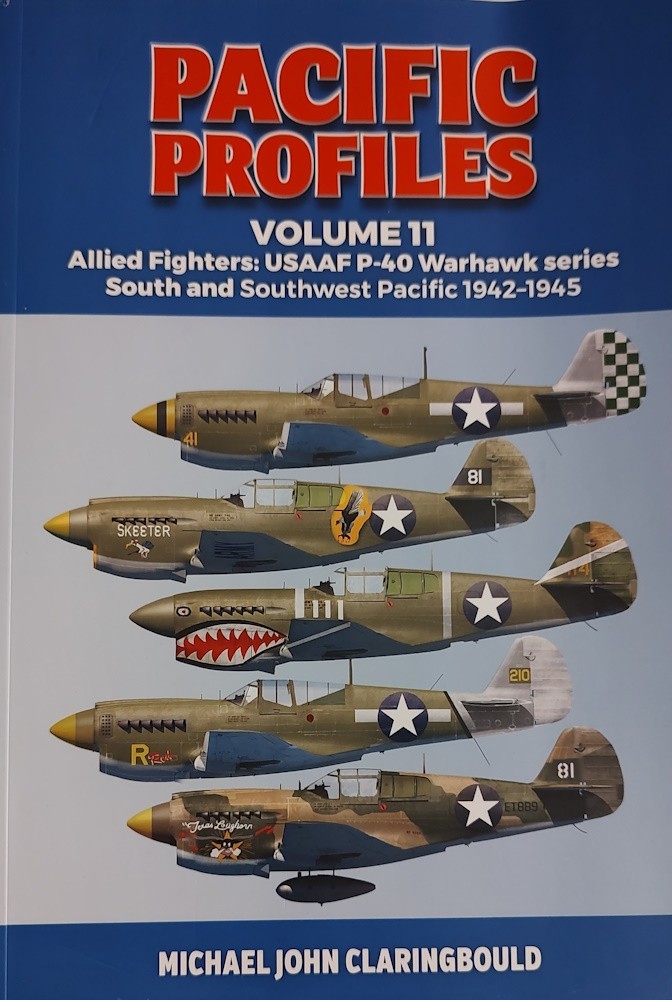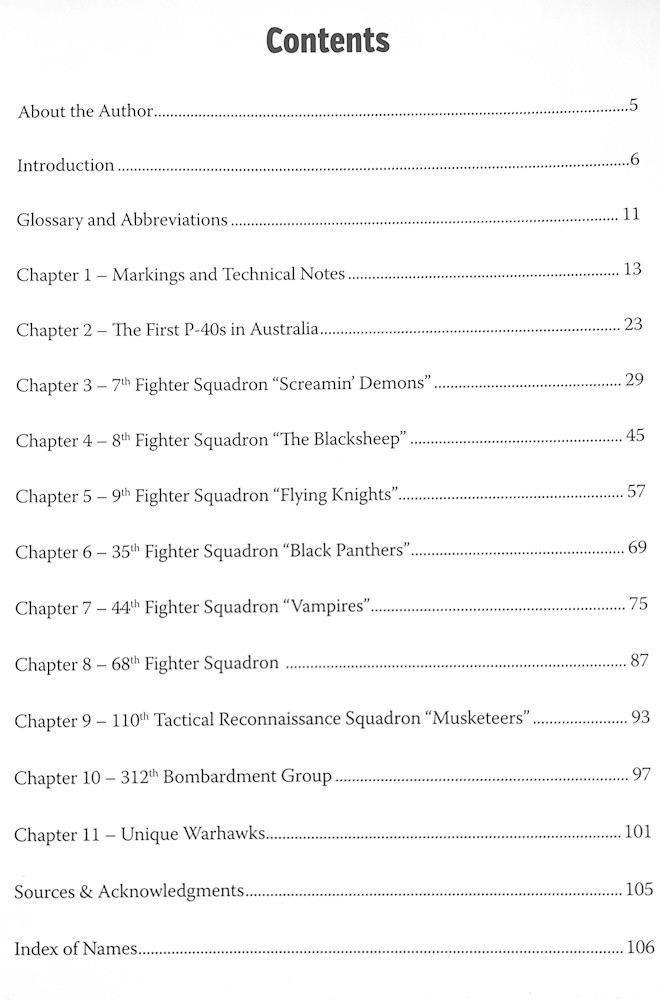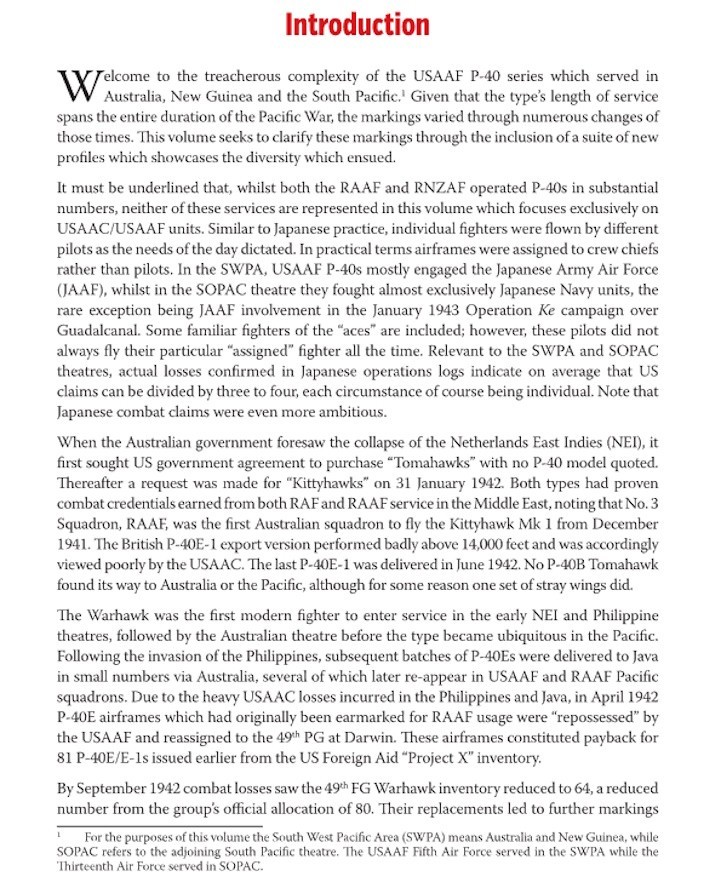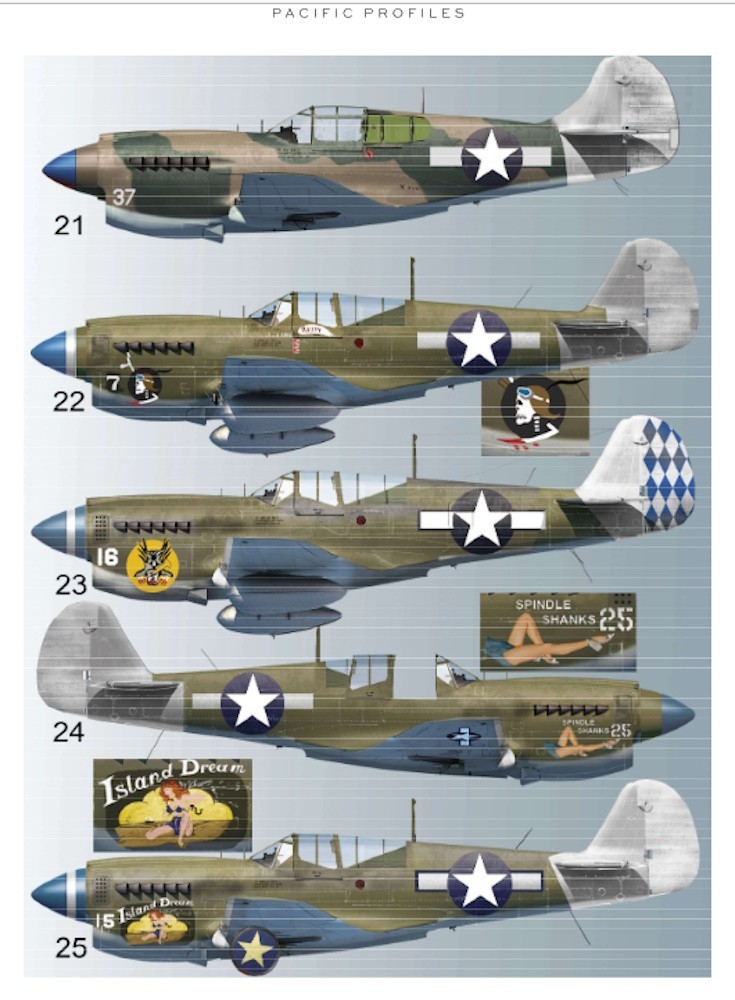
Introduction
Pacific Profiles Volume 11 Allied Fighters: USAAF P-40 Warhawk series South and Southwest Pacific 1942-1945 is a recent title from Avonmore Books.
Modelers and students of the early Pacific War air war should be excited by this new study of American P-40s in Australia, New Guinea and the Solomons. Green pilots flying P-40Es miscast as interceptors challenged perhaps the best air superiority force in the world - Japanese Navy Zero-sens, and later, the Japanese Army's nimble fighters. As different models intended to improve the P-40 showed up, so did new markings and camouflage finishes. For over three years, those P-40 squadrons demonstrated why the P-40 is christened “the best second-best fighter of WW2.”
This 108-pqge softcover measures 250 x 176mm.
Author: Michael Claringbould
ISBN 9780645700435
$36.95
Mr. Claringbould's credentials are mentioned in previous reviews; raised in Port Moresby, Papua New Guinea, these subjects are a life-long pursuit of his and he has authored more than 20 other titles. Most concern the air war in the South Pacific. His series Pacific Profiles currently offers 14 titles, focusing on Allied and Japanese fighters, bombers, transports and miscellaneous types, and Japanese seaplanes.
Keeping track of aircraft and their camouflage and markings as they transfer between units and spend varying times in maintenance depots, all while official and temporary regulations were implemented and withdrawn, can drive aircraft modelers and historians batty. An example from the other side of the world from this study is a P-40 in Italy in 1944, painted in RAF desert colors, with “U.S. Army” under the wings, six U.S. national insignias painted over with RAF insignia and tail flash, yet with United States Army Air Force (USAAF) unit codes on the fuselage and serial number on the tail; presumably it was hastily included in Lend-Lease, retained and used by USAAF, and eventually transferred to Commonwealth forces. Similar back-and-forths also occurred in the Pacific resulting in the same cursory confusion for researchers. Addressing those conundrums, the author explains the difficulty in keeping track of different airframes and the markings on them, pointing out that air depots and maintenance facilities could have dozens of aircraft coming in from many squadrons simultaneously, ultimately being fed back to various squadrons as they were ready, whether to the original squadron or not. Even within the same squadron, depending on the time it took to get an aircraft airworthy again, there could be significant changes in markings and camouflage. Avonmore tells us:
The ongoing Pacific Profiles series presents the most accurate WWII profiles of aircraft which served throughout Australia, New Guinea and the South Pacific. This Volume 11 covers the P-40 Warhawk series, which served with a dozen USAAF Fifth and Thirteenth Air Force fighter and reconnaissance squadrons, service units, combat replacement pools and other miscellaneous units.
Most profiles are presented for the first time, alongside markings derivations, including squadron heraldry and codes. Frequent airframe reassignments between units resulted in wide-ranging and oft-changing unit markings and nose art. Until now there has been a paucity of material about several units, particularly those in the Thirteenth Air Force. This volume also rectifies past mistakes which continue to be perpetrated, especially those representing the early Australian theatre.
Wide ranging primary reference material is cited including official Australian assignment data, squadron records, colour slides and movies, maintenance logs, diaries, wreck site inspections and factory specifications. A brief history of each unit and the rationale of its unit markings accompanies the text.
The author is world-renowned for his expertise on the Pacific air war. Never before have USAAF Pacific P-40s and their colourful artwork been illustrated with such accuracy and detail.
This book is about United States Army Air Force (USAAF) P-40s and does not cover the large numbers of Australian and New Zealand P-40s. With the large number of P-40s used by those air forces, I hope there will be such a title forthcoming. Maybe even a title purely about the New Zealand Air Force, equipped with P-40s, C-47s, Dauntless dive bombers, Corsairs, B-24s, and other aircraft types? So many potential titles. Fingers crossed.
Content
USAAF P-40 Warhawk series South and Southwest Pacific 1942-1945 is told through 108 pages of 11 chapters (and front and rear material):

Generous galleries of illustrations and photographs fill these pages. After a brief introduction about the author, the book presents two pages with three maps, followed by Glossary & Abbreviations presenting common terms and usage, e.g., FCRC = Fighter Command Replacement Center, Kokutai = Japanese naval air group, FS = Fighter Squadron.
Introduction does just that - it introduces us to the various P-40 models and modifications that served in the South Pacific, Australia, and New Guinea. This chapter provides the chronology of the first P-40s to come to the South Pacific when the Australians wanted to purchase Tomahawks, changing the order to Kittyhawks in January 1942. Thanks to the availability of records, we learn of the number of P-40s that arrived in Australia, and how many were still on the 5th Air Force roster by May 1943, and even into 1944. The author discusses maintenance pools and the result of those creating a confusing riot of camouflage, markings, serial numbers, etc. The details he provides are very interesting, i.e., the pilot who flew the last P-40E to make a combat claim in New Guinea, including the aircraft's serial number, squadron it was assigned to, and the date of the kill. The author continues to explain the P-40 in the Pacific by model numbers. Next, he examines the P-40F models that operated in the South Pacific. Then came the P-40Ms, and finally the various P-40Ns. His level of detail discusses the odd block numbers of the P-40N that showed up in the South Pacific versus the Southwest Pacific. Introduction proves to be a very compact concise history of the P-40 family.
Not only does the author provide a great deal of technical and operational information, he also provides curious antidotes. For instance, no P-40 B's or Cs made it to the South Pacific, although for some reason, one set of wings did. We also learned that USAAF had some Brewster Buffaloes on hand and what became of those aircraft. The author continues to explain the problem of keeping track of various airframes when American units began to move from Australia into New Guinea, across the mountains, and then up the coast towards Tokyo.
Chapter 1, Markings and Technical Notes highlight the technical peculiarities between P-40s, such as what models had interchangeable components, i.e., upper and lower cowlings. Many models could use any of the three main exhaust pipe patterns. We also learn of those odd not-serial numbers on the tail, and the origins of white IFF (identification Friend or Foe) markings. Four sub-chapters further highlight, point out factory inconsistencies, and illustrate:
- P-40 Model Variations: the eight primary models and their spotting features
- Markings & Stenciling: 12 examples
- USAAF Tailplane Box & Serial Numbers: 9 examples
- P-40 Series Fuel Drop-tank Attachment Layout: five views, including the 200-gallon "Brisbane tank."
Chapters 2-11 introduces us to the air units, i.e., The First P-40s in Australia explains the earliest arrival of P-40s and their odyssey to the Java front - and back. Pacific Profiles is a wealth of information and each chapter begins with a history of the unit including (when known):
· Commanding officers
· Establishment location and training areas if pertinent
· Base of arrival/operations in-theater
· Aircraft unit codes
· Aircraft manufacturer numbers
· Date of commencement of operations
· Combat
· Losses
· Transfers
· Re-equipping
When available, each unit history includes the record of losses of pilots and aircraft (with name and cause when known), and unit nickname. (Ever hear of the Japanese flyingboat crew who became POWs after shooting down the straggler P-40 that shot them down while they threatened a warship?
Photographs, Artwork and Graphics
Aside from the airplanes, modelers will find a wealth of source material for airfield paraphernalia to create and detail dioramas. As stated in previous Pacific Profile reviews, these books feature an amazing gallery of black-and-white and even a color photo to support the text. They span the gamut of professionally exposed and developed images to amateur pictures. Some are stills taken from motion pictures. Some show damaged aircraft. The author chose excellent images that visually confirm insignias and odd P-40 finishes.
Perhaps the most impressive part of the book is the original color artwork by the author of select aircraft. As previously mentioned, each profile is supported by photos and/or documentation. The publisher writes:
Each profile has been produced by citing wide-ranging reference material, including official squadron records, colour movies, maintenance logs, diaries, wreck site inspections and thousands of photos including colour slides.
As in the artist’s other books, weathering and wear is illustrated. His experience as a pilot allows him to render atmospherics for in-flight illustrations.
Many profiles are authenticated with a wartime photograph of the aircraft. Most of the profiles include a line or two of narrative of the history of the aircraft, some consist of a small paragraph.
Artwork
As are the photographs, the illustrations are a treasure trove for modelers. While the academic and technical research is the brain of this book, perhaps the most impressive part is the original color artwork that visually spotlights what the text imparts. The author richly illustrates select P-40s – 110 profiles - and dozens of supporting illustrations. Those renders present unique markings, insignia, camouflage. Illustrating the basing of P-40s are maps of their deployment. Recall that many profiles are authenticated with a wartime photograph of the aircraft.
A. Four pages of renderings reproduce the dozens of aforementioned P-40s and their technical and operational markings.
1. P-40 Model Variations.
2. Markings & Stenciling.
3. USAAF Tailplane Box & Serial Numbers.
4. P-40 Series Fuel Drop-tank Attachment Layout.
B. Scores of aircraft and group/squadron/personal insignias are illustrated.
1. Early Warhawks: five profiles and three close-ups of the 3rd, 17th and 33rd (Provisional) Pursuit Squadrons.
2. 7th FS: 20 profiles of P-40s with 17 close-ups of unit insignias and personal markings.
3. 8th FS: 20 profiles of P-40s with 25 close-ups of unit insignias and personal markings.
4. 9th FS: 20 P-40 profiles; 19 close-ups of unit insignia and personal markings.
5. 35th FS: 10 P-40 profiles; 9 close-ups of unit insignia and personal markings.
6. 44th FS: 15 P-40 profiles; 9 close-ups of unit insignia and personal markings.
7. 68th FS: 5 P-40 profiles; 2 close-ups the unit logo/personal markings.
8. 110th TRS: a trio of P-40 profiles with the unit emblem close-up.
9. 312th Bombardment Group: 5 P-40 profiles; 7 close-ups of unit logo/personal markings.
10. Unique Warhawks: 7 P-40 profiles including a Warhawk of the 418th Night Fighter Squadron.
11. P-40F over the Solomons - in-action art.
C. Maps
1. Fifth Air Force Main P40 Bases 1942-1944.
2. Key Air Bases Used By the 13th Air Force P-40s In the Solomons of the South Pacific Area Command During 1942-44 encompassing from Guadalcanal to Bougainville.
3. Fifth Air Force P-40 Main Bases 1942-44 in Australia showing the assembly bases.




Conclusion
Mr. Claringbould and Avonmore have provided yet another incredible book for modelers, students and historians of the P-40 in the South Pacific air war. Modelers of P-40s now have a modern wonderful resource to inspire model subject of Fifth and Thirteenth Air Force P-40s and Avonmore's Pacific Profiles Volume 11 Allied Fighters: USAAF P-40 Warhawk presents them in 110 vivid profiles. The accuracy of the color profile interpretations are authenticated by contemporary photographs. While I would acquire this book for the gallery of images alone, the research presented by the text is illuminating and fascinating. I am thrilled that the author chose the P-40 for a Pacific Profiles volume and enthusiastically recommend it.
Now to start building P-40 models!
Please remember to mention to Avonmore Books and retailers that you saw this product here - on Aeroscale.




























